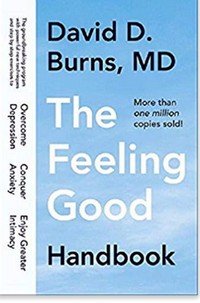Ten Cognitive Distortions
REBT-CBT is built on the premise that we all make fundamental mistakes in the way we think about ourselves, other people and life in general, and that these mistakes (irrational beliefs and cognitive distortions) are the real cause of (virtually all) of our misery and dysfunction and failure. This is so important! Continue reading to see a complete list, explanation of and tips for how to use the Ten Cognitive Distortions and Four IB’s (Irrational Beliefs) as conceptualized by David Burns, Aaron Beck and Albert Ellis.
|
Both are valid! And there is nothing inherently magical or sacred about the numbers 10 or 4. They are just different perspectives on the same content and dynamics. All of the ten are contained within the Big Four. Burns could have just as easily organized them as 12 or 20 or 8. Lists of 10 items are always a catchy way to organize ideas when you are writing books and especially when you are trying to sell those books, but 10 and 4 are certainly not inherently more correct than any other number. The trick, I suppose, is to choose a number that is sufficiently informative while remaining “user friendly.”
I do wish that more people would take me up on my earnest recommendation that the process I describe below is the a way of getting the most out of this list rather than just reading it once-over and saying “Isn’t that nice!” and then never looking at them again, never mind applying them in daily life.
Rex’s 7 Steps to working the
Cognitive distortions
Then, memorize them! I can hear you protesting already, “Rex! Surely you must be joking!” No, I am not joking. That’s right, I said “memorize” them. I realize that may seem really “old school” and not very amusing . . . but it works! It really works and will pay off in dividends much greater than the time and energy you invest committing them to memory. Think about it. How can you ever learn and understand anything if you don’t first remember it? Or to put it another way, how can you possibly understand why you know what you know, or why you know what you understand if you can’t remember it? Duh! If you normally use peg and link memory systems, this will seem obvious to you and it will be a snap. If not, just a little boring work. But the boring work will yield great benefits as you move toward being able to actually apply this process to your problems in a meaningful and useful way, rather than just “thinking about them.”
2. Then, write about your problem, or choose something you have already written. You can do exactly the same thing with nearly anything that your or another person has written, fact or fiction, to great benefit.
3. With your list of Cognitive Distortions at hand, carefully go thorough the material you have collected and written to see how many of the distortions you can identify. Yellow highlight them. Especially, be on the lookout for any (moralistic) shoulds, oughts and musts, and disguised shoulds in the form of “Why?” questions and “I can’t believe it!”
4. Go back over the highlighted distortions. Can you see (really “get it) that these distortions are indeed distorted, often completely false, illogical, irrational and most important, unhelpful. Can you see how these distortions are actually provoking and evoking unpleasant feelings and disturbed emotions? Great! Can you see how these emotions might be leading you to behave in ways which are unrewarding and self-defeating? Great!
5. Do you really “get it”? Fine, now you can begin to replace this distorted thinking with thinking that is “cooler,” more rational and helpful, less provocative and inflammatory. Do you actually believe what you are telling yourself? Really? Great!

7. Take rational action that is counter to habitual, self-defeating behavior you are working on.
I believe this process to be sound and intuitively correct; a natural, organic process, which operates no matter whether you follow the procedure above or use the Burns Three Column Technique, or Ellis’s ABC method, or Edelstein’s Three Minute Technique, or other formats. We have provided a selection of self-help forms for you to use. The technique and the form and the format are merely ways or organizing your thinking. Please, don’t get hung up on the form. Don’t fall into the trap of filling in forms becoming an exercise in the tail wagging the dog.
I don’t care if you do this climbing a tree and talking to your cat while eating rocky road ice cream. The object is to change, really change, the self-defeating beliefs that are making you miserable.
|
That’s all folks!
Continue reading to see the list of the ten cognitive distortions and the “The Big Four.”
Message me or join the discussion and add your questions, comments, thoughts, whatever in the box all the way at the bottom of this page. I look forward to hearing from you.
Definitions of the
Ten Cognitive Distortions

1. ALL-OR-NOTHING THINKING
You see things in black and white categories. If your performance falls short of perfect, you see yourself as a total failure.
2. OVER GENERALIZATION
You see a single negative event as a never-ending pattern of defeat.
3. MENTAL FILTER
You pick out a single negative detail and dwell on it exclusively so that your vision of all reality become darkened, like the drop of ink that discolors the entire beaker of water.
4. DISQUALIFYING THE POSITIVE
You reject positive experiences by insisting they “don’t count” for some reason or another. In this way you can maintain a negative belief that is contradicted by your everyday experiences.
5. JUMPING TO CONCLUSIONS
You make a negative interpretation even though there are no definite facts that convincingly support your conclusion. There are two versions:
a. Mind Reading: You arbitrarily conclude that someone is reacting negatively to you, and you don’t bother to check this out.
b. The Fortune Teller Error: You anticipate that things will turn out badly, and you feel convinced that your prediction is an already established fact.
6. MAGNIFICATION (CATASTROPHIZING) OR MINIMIZATION
(This is Dr. Ellis’s #2 below): You exaggerate the importance of things (such as your goof-up or someone else’s achievement) or you inappropriately shrink things until they appear tiny (your own desirable qualities or the other fellow’s imperfections). This is also called the “binocular trick.”
7. EMOTIONAL REASONING
You assume that your negative emotions necessarily reflect the way things really are: “I feel it, therefore it must be true.”
8. SHOULD STATEMENTS
(This is Dr. Ellis’s #1 below) You try to motivate yourself with shoulds and
shouldn’ts, as if you had to be whipped and punished before you could be expected to do anything. “Musts” and “oughts” are also offenders. The emotional consequence is guilt. When you direct your should statements toward others, you feel anger, frustration, and resentment.
9. LABELING AND MISLABELING
(This is Dr. Ellis’s #4 below): This is an extreme form of
overgeneralization. Instead of describing your error, you attach a
negative label to yourself: “I’m a loser.” When someone else’s behavior rubs you the wrong way, you attach a negative label to him: “He’s a goddamn louse.” Mislabeling involves describing an event with language that is highly colored and emotionally loaded.
10. PERSONALIZATION
You see yourself as the cause of some negative
external event which in fact you were not primarily responsible for.
Table 3-1, _Feeling Good_
David D. Burns, MD
 |
 |
 |
 |
And Ellis reduces these IB’s to, as I call them,
“The Big Four”
(1) Demanding,
(2) Awfulizing,
(3) Low Frustration Tolerance, and
(4) People Rating,
 |
 |
 |
 |

![]()
How useful was this post?
Click on a star to rate it!
Average rating 5 / 5. Vote count: 3
No votes so far! Be the first to rate this post.
Originally posted 2019-08-24 18:57:56.
Contact: Rex@REBTinfo.com
- Is keeping emotions “bottled up” dangerous? - Mon 22 Dec 25
- More than 20 titles by Dr. Ellis now available on Kindle - Sun 21 Dec 25
Tags: beck, Burns, ellis, For Irrational Beliefs, Ten Cognitive Distortions
Search this site
Sticky Posts
Regular Columns & Features
Categories
USEFUL LINKS
Amazon Associate Member
Rex Alexander and REBT Info are participants in the Amazon Services LLC Associates Program, an affiliate advertising program designed to provide a means for sites to earn advertising fees by advertising and linking to amazon.com.
Disclosure
When you buy items using the links on this website, we may get a small commission which keeps me in coffee, which keeps me working, which keeps me providing valuable content for you. Thank you for your continuing support of REBT Info.com. ~Rex
TOS / Terms of Service
Pretty basic stuff: No fussing, no fighting, no cussing, no spamming, no scamming, no blaming, no flaming, no hating, no bating, no trolling, no personal attacks. No pornography (Damn!). The Golden Rule applies. Focus on issues, ideas and principles rather than on personalities and you will fit right in. Please keep your contributions friendly and polite, treat your fellow members and readers with respect and all will be well.
All content and information submitted become the property of REBT Info (REBTinfo.com)
Privacy Policy
PRIVACY POLICY
We at REBT Info value your privacy. Your personal information is secure with us. Secure server software (SSL) encrypts all information you enter before it is sent to us, and all of the customer data we collect is protected against unauthorized access.
We WILL NOT sell, rent, distribute or otherwise share your personal information, including e-mail address, to or with anyone for any reason (except in the extremely rare, unlikely case of demands by duly authorized law enforcement acting strictly in accord with due process).
For more information, please read the long version
Copyright
Copyright © 2012-2025 by Rex Alexander dba REBT Info / http://REBTinfo.com.
All rights reserved. The content of this website or any portion thereof may not be reproduced or used in any manner whatsoever
without the express written permission of the publisher except for the use of brief quotations in a book review.Disclaimer
This website, REBTinfo.com, and others under the REBT Info family are for education, information and entertainment purposes only; are not intended as, nor should be regarded as medical or psychiatric diagnosis, advice or treatment.
By accessing this blog you understand and agree to these conditions, as well as to the other Terms of Service / TOS posted, and which may be updated and amended from time-to-time.
Agreement
By accessing this website blog and related media, you affirm that you have read, understand and agree to our Terms of Service / TOS which may be updated and amended from time-to-time.
This is a public blog
Anything you post may be viewed by the public. Therefore, do not post anything you wish to remain private.






